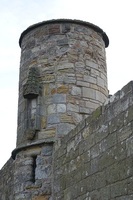Cathedral Precinct
Cathedral Precinct
During the Middle Ages St Andrews Cathedral was surrounded by buildings. There was accommodation for the canons who served the cathedral, housing for pilgrims who visited St Andrew's shrine, barns for storing the food and produce given to the church, and a large watermill for grinding grain. Around the edge of this vast religious complex there ran a stone wall, much of which still survives. The original wall was probably built in the fourteenth century. In the early 1500s the cathedral's prior, John Hepburn, gave orders for the wall to be heightened. Building work continued under John's nephew, Prior Patrick Hepburn, who commissioned the construction of several new towers. The difference between the older stonework and the Hepburns' improvements is visible in a number of places on the wall.
Elizabeth Rhodes on the significance of the Cathedral Precinct Wall
Elizabeth Rhodes on the arrival of Mary of Guise in St Andrews
Roger Mason on the significance of the St Andrews Cathedral and the reformation
Street View
Additional Information
Location: Encircling the Cathedral and St Leonard's School. Date Built: Probably fourteenth and sixteenth centuries.
The wall was partly constructed from reused stones. In the nineteenth century fragments of carved Celtic crosses were found in the wall.
The arms of Prior John Hepburn can be found in several places on the wall. Look out for a shield with a crozier (a stick with a curled head like a shepherd's crook) behind it.
There were a number of gateways through the wall. The most notable of these is the Pends. There is also a gateway to the harbour, and one on the south side which was used for the delivery of grain.
There used to be 16 towers, but only 13 now survive.
According to a Victorian legend the square tower on the north side of the wall is haunted.
